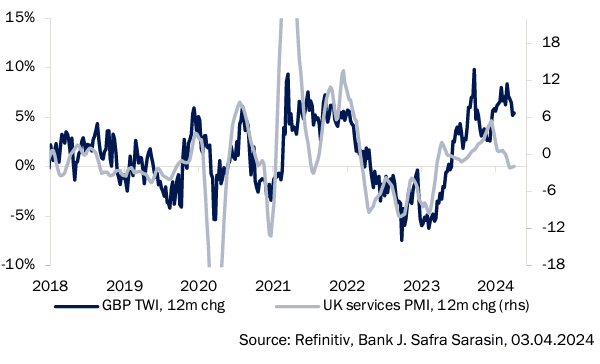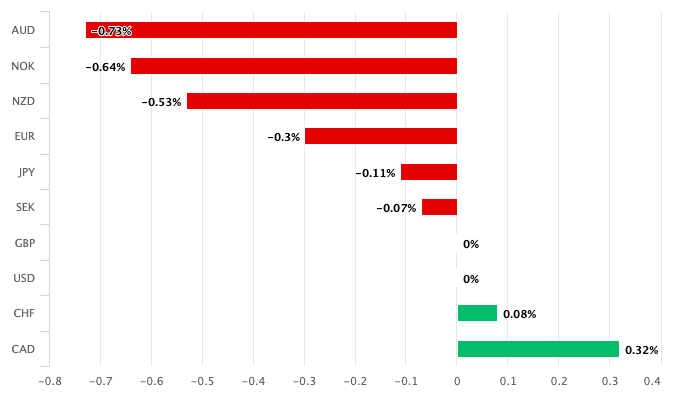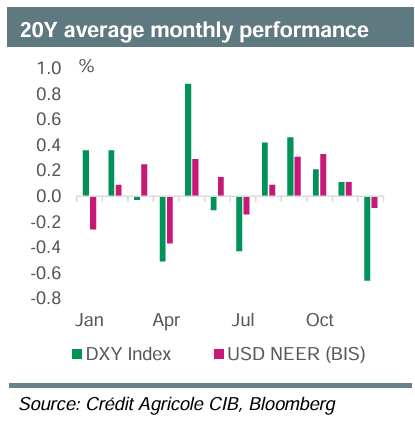Pound Sterling's Soggy Start to a Bright Month
- Written by: Gary Howes

Image © Adobe Stock
The British pound has endured a soggy start to the new month, and analysts at Danske Bank expect further weakness in the coming months, while others remind us April is typically a strong month for the currency.
The soggy start to April is not just metaphorical: one of the wettest starts to the year continues to impact the UK economy, with the British Retail Consortium reporting Friday that Easter failed to reverse the footfall decline on UK high streets.
"UK footfall declined in March as the wet weather kept shoppers indoors," says Helen Dickinson, Chief Executive of the BRC. Total UK footfall decreased by 1.3% in March (YoY), up from -6.2% in February.
"As the everywhere economy, retail serves all of us, providing the products we need as well as local jobs and investment," says Dickinson.
Above: "Sterling upside seems limited given the UK macro data" - Bank J. Safra Sarasin.
The Pound has lost ground against most of its G10 peers in the past week, with losses particularly notable against commodity currencies, which have benefited from renewed hopes the Federal Reserve will cut interest rates in July.
The Pound to Euro exchange rate has meanwhile fallen to 1.1660 and looks set to record a sixth consecutive daily loss. To be sure, the Pound to Dollar exchange rate has fared better having recovered to 1.2625, but this is exclusively down to broader USD weakness.
Compare Currency Exchange Rates
Find out how much you could save on your international transfer
Estimated saving compared to high street banks:
£25.00
Free • No obligation • Takes 2 minutes
Analyst Kirstine Kundby-Nielsen at Danske Bank says Pound Sterling underperformance can be attributed to softer data out from the UK. She says the final PMIs for March were slightly lower than the preliminary prints with composite at 52.8 (preliminary: 52.9) and services at 53.1 (prelim: 53.4).
But the undershoot against expectations is what ultimately matters for FX, and can explain the Pound's broader underperformance.
"Downside risks for the currency thus appear larger than upside risks at the current juncture," says Wolf von Rotberg, Equity Strategist at J. Safra Sarasin. "Sterling appears expensive, given a moderation in UK macro data."
Above: GBP performance in the past week. Track GBP with your own custom rate alerts. Set Up Here
Results from the Bank of England's DMP survey were also released Thursday and indicate easing inflation and wage growth expectations across the board.
One-year ahead CPI inflation expectations at UK businesses declined further to 3.2% in March (from 3.3%) and expected year-ahead wage growth declined to 4.9% on a 3M MA basis (from 5.2%).
"Overall yesterday's releases were good news for the BoE," says Kundby-Nielsen. The Bank of England will be increasingly confident that it can cut interest rates in the coming months, with a June rate hike fully expected by markets.
The problem for those wanting a stronger Pound is that the Bank of England could now cut before the U.S. Federal Reserve and will cut alongside the European Central Bank.
Track GBP with your own custom rate alerts. Set Up Here
Interest rate expectations are the number one driver of currencies in 2024, and any hint the Bank of England can lead the rate-cutting cycle (and deliver more cuts than its peers) is negative for the Pound.
"The primary driver of GBP/EUR over the past year has been relative monetary policy divergence," explains Paul Robson, Head of G10 FX Strategy at NatWest Markets.
Danske Bank expects the UK economy to underperform in the coming months; judging this will weigh on the Pound as it would allow the Bank to cut interest rates.
"We expect weaker UK data to increasingly weigh on GBP the coming months," says Kundby-Nielsen.
However, April is typically a favourable month for the British Pound, and analysts say that the currency can appreciate against the Euro and Dollar over the coming weeks as seasonal factors take effect.
"April ranks among the best months of the year for the pound thanks to the repatriation by corporates of overseas FX for dividend payments. The average percentage monthly gain of the last ten years in April is 0.8%. The standard deviation is 2.2%," says Kenneth Broux, a foreign exchange analyst at Société Générale.
Broux says gains are particularly noticeable in the Pound to Dollar exchange rate, but the Pound to Euro exchange rate also benefits.
Kamal Sharma, FX Strategist at Bank of America, says "April is the sweet spot for GBP. If history is any guide, a test of $1.30 in GBP/USD is likely."







